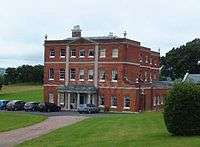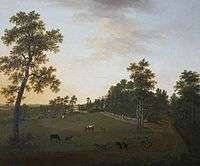Whiteway House


Whiteway House near Chudleigh in Devon is a Grade II* listed Georgian house set in parkland built in the 1770s with early 19th-century alterations. It is situated 2½ miles north of Chudleigh, at the foot of the Haldon Hills. The house had formerly a 5-bay north-east wing, a service range and a separate 19th-century service block to the rear, all demolished since 1962.[1]
Descent of the estate
Bennett
The Devon topographer Thomas Westcote (d.1637) gives the pedigree of the family of Bennett as follows: " Richard Bennet married Julian, daughter of William Whiteway of Chudleigh parish, and had issue Nicholas, William, and John. Nicholas married Elizabeth, daughter of Thomas Pomeroy, of Brindley in the parish of Harberton, knight, and had issue John, William sine prole, English, (married to Thomas Thorn of Mamhead;) Julian, (to Roger Harewell of Kingsteignton;) Joan, (to Peter Bear of the same;) Sabine. (to Humphrey Ball of Chudleigh.) John married a daughter of John Trosse, of Exeter". The last mention of the name in the Parish Register is in 1634.[2] The arms of Bennett of Whiteway are given by Westcote as: Sable, a chevron erminois between three tripled ears of wheat or.
Parker

The present house was built in the 1770s by John Parker, 1st Baron Boringdon (1735–1788) of Saltram House, Plympton. The estate had been purchased in 1722 by his grandfather George Parker (d.1743) of Boringdon and North Molton, both in Devon, as the following summary of a deed dated 14 March 1722 relates:[4]
"Agreement 1) George Bennett and Henry Bennett, his son and heir apparent, both of Whiteway 2) George Parker of Boringdon, esquire. Conveyance of the estate of inheritance in fee simple of the tenements called Whiteway, Wolcombe and Oxencombe"
He had also purchased Saltram before in 1712 and at another time Polsloe Priory. Whiteway became the residence of Lord Boringdon's younger brother Montagu Edmund Parker (1737–1813), of Blagdon, who was Sheriff of Devon in 1789 and whose two portraits by Sir Joshua Reynolds and John Downman survive at Saltram House.[5] It became the residence of his grandson Montagu Edmund Newcombe Parker (1807–1858), Conservative MP for South Devon (1835–41) and Sheriff of Devon in 1849, whose tomb can be seen in Chudleigh churchyard. [Lord Boringdon's grandson Edmund Parker, 2nd Earl of Morley (1810–1864) married in 1842 Harriet Parker (1809–1897), his second cousin and sister and heiress of Montagu E.N. Parker, and Whiteway thus returned into the possession of the senior line of the family when it became in 1897 the inheritance of Hariett's son Albert Edmund Parker, 3rd Earl of Morley (1843–1905). The 3rd Earl had inherited debts of £200,000 from his father who had been forced by his poor financial situation to let Saltram to tenants from 1861, three years before his death, which tenancies continued for 23 years until 1884. During this exile from Saltram the Earls lived partly abroad, in rented London houses and at Whiteway with the Dowager Countess Hariett. The 2nd Earl died at Whiteway on 23 August 1864.[6] The 3rd Earl married well to a wealthy heiress, Margaret Holford, daughter and eventual heiress of the very wealthy Robert Stayner Holford of Westonbirt House in Gloucestershire, and finances recovered temporarily until the agricultural slump of the start of the 20th century forced the 4th Earl to let Whiteway in 1911,[7] the proceeds from which he used to make improvements at Saltram. However the family's finances did not recover and he sold Whiteway in 1923.[8] The Parker family of Whiteway acquired the manor of Collaton St Mary, near Paignton, the public house of which is still called (in 2012) the "Parker Arms".[9]
Farquhar
It appears that the house had been let to Ernest Farquhar (1853–1930), grandson of Sir Thomas Harvie Farquhar, 2nd Baronet of Cadogan House.[10] He married Maria Theresa Lister, daughter of Sir Thomas Villiers Lister and had two sons, the younger of whom was Lt. Rupert Farquhar MC of the 4th Battalion Grenadier Guards, killed in action on 17 September 1917 in Belgium aged 20. His tombstone in the Canada Farm Cemetery in Belgium records his parents as of Whiteway in Chudleigh [11] as does his entry on the Chudleigh War Memorial. His eldest son was Sir Harold Lister Farquhar (1894–1953), MC, CMG, Ambassador. The occupant in the 1960s was Alfred Farquhar, who had a notable collection of fine art. [12]
Legge
Whiteway was offered for sale in 1973.[13] In 2000 Whiteway was purchased with 281 acres by Raine Spencer, Countess Spencer (b. 1929), who had married as her first husband Gerald Legge, 9th Earl of Dartmouth (d. 1997), from whom she was divorced in 1976. The estate was being operated in 2002 by her son the 10th Earl of Dartmouth as a commercial shoot.[14]
Sources
- Johnson, Ceri. National Trust guidebook "Saltram, Devon", 2005
- British Listed Buildings text, Whiteway House, Chudleigh
- Jones, Mary. The history of Chudleigh, in the County of Devon, and the Surrounding Scenery, Seats, Families, etc. History of Chudleigh, c. 1870, Chapter 8
References
- ↑ Listed Building text
- ↑ "History of Chudleigh". Uk-genealogy.org.uk. Retrieved 2013-10-05.
- ↑ Debrett's Peerage, 1968, Earl of Morley, p.795
- ↑ Plymouth and West Devon Record Office, Morley of Saltram 69/M/2/331
- ↑ See images
- ↑ History of Chudleigh, Chap. 8
- ↑ Johnson, p.56
- ↑ Johnson, p.57
- ↑ http://www.collatonstmary.org.uk
- ↑ "Person Page 44410". Thepeerage.com. Retrieved 2013-10-05.
- ↑ "The War Graves Photographic Project". Twgpp.org. 1917-09-17. Retrieved 2013-10-05.
- ↑ The Chudleigh History Group relates the recent history differently: "The Parkers remained until 1896 at which time through marriage (seemingly erroneous, no such marriage is discoverable) it passed to the Farquhar family. In the Farquhars time the estate comprised over 1000 acres and 800 acres of woodland on Haldon Moor, the Farquhars remained up until 1967"
- ↑ Listed Buildings text
- ↑ Daily Telegraph 18 October 2002
Coordinates: 50°38′07″N 3°35′23″W / 50.6353°N 3.5897°W